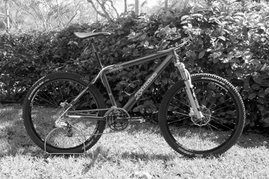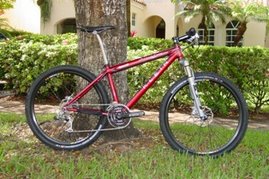Monday, August 25, 2008
Friday, August 1, 2008
Shimano DA Di 7970 Full Electronic Shifting!!
for high-end road bikes that it claims will vastly improve performance and
reduce maintenance. By replacing the conventional levers that pull wound-steel
cables through protective housings with solid-state switches and rubber-coated
wires, there's no chance for road gunk to clog things up and interfere with
shifting, or, for that matter, your post-ride beer.
The principle of an electronically controlled drive train is to execute
perfect shifts every time, thus "reducing mental overhead," in the words of
Shimano marketing manager Devin Walton. This is a resource cyclists find in
short supply during epic rides.
Thursday's announcement that the system, called Di2, will hit shops in
January 2009 settles a question first raised in 2005 when prototypes began
cropping up on the bikes of select Shimano-sponsored racers in the pro
peloton. The system's development has been photographed, chronicled and
Angsted over ever since.
But if the existence of electronic shifting comes as no surprise, its
weigh-in certainly should. During a recent telephone interview, an industry
insider who spoke on condition of anonymity stopped cold amid a
why-do-we-need-this diatribe, upon learning that Di2 weighs less than
Shimano's current generation of parts. According to the company, Di2 will be 67
grams lighter than the current
Dura-Ace 7800 and only 68 grams heavier than Dura-Ace 7900, the snazzy
forthcoming 2009 suite of parts. "I'll be going to hell," said the source, who
then fell silent -- no doubt converting grams to ounces to fractions of a pound
to the limitless advantages of such weight savings. That's at least an extra
Clif Bar.
Di2's front derailleur automatically adjusts itself so
the chain doesn't rub as you shift.
Shimano plans to offer the electronic setup as an upgrade option within the
7900 group -- which is preselling for $2,600 -- so parts such as the two-tone
cranks and brakes will be the same. (No word yet on the additional cost for
electric; it could be double.) Di2 consists of two brake-and-shift levers, two
derailleurs whose springs have been replaced by servo-motors, a 7.4-volt
lithium-ion battery pack, and the wiring harness that connects everything.
The derailleurs, whose job is to move the chain from gear to gear as you
shift, talk to each other and automatically adjust so the chain doesn't rub.
They also calibrate themselves, so you don't have to play with cable tension to
maintain shift quality as cables stretch and the chain and cogs wear. And
although the control buttons have been placed in the traditional location behind
the brake levers -- so as not to confuse anyone or overly tax that mental
overhead -- they could be integrated with the ends of time-trial bars, the top
of the handlebars or just about anywhere a rider might find convenient.
Still, the advantage that people who've experienced the system talk about is
how little effort it takes to change gears. A quick nudge to one of the shift
switches signals a motorized worm gear in the derailleur to instantly move the
precise amount it needs to. Fractions of a second later, the chain snaps into
position.
Chris d'Aluisio, director of advanced research and development for
Specialized, likens the difference between mechanical and electric shifting to
the difference between driving a race car with a manual transmission and one
with F-1 style paddle shifters. "You can stay on the gas and flip through the
gears with no hesitation," said d'Aluisio. "It's seamless power."
Frankie Andreu, who raced in nine Tours de France, described the shifting as
"immediate and very smooth and accurate.... It's super nice."
Even my curmudgeonly unidentified source said, "The shifting is mind-blowing:
I mean, you just touch the button, and it shifts."
The shift buttons are located in the traditional place --
behind the brake levers -- but they could go anywhere without affecting
the performance of the system.
Like the 7900 mechanical derailleur, the 7970 has a
new carbon fiber rear pulley cage, and the new design is compatible with
wider-range cogsets, accommodating up to 27 teeth. Driven by a servo
motor instead of a cable and spring, shifts are identical and precise
due to the computer control unit analyzing each shift.
But let's not lose perspective. Shimano isn't the first company to attempt
electronic shifting. Mavic introduced
Zap in 1994 and then a wireless version called Mektronic in 2000, neither of
which survived. Zap's wires proved to be less than waterproof, and Mektronic was
finicky to set up properly. Shimano, notorious for its rigorous testing
gauntlet, is betting that its engineers have solved the electricity problem --
and so is Campagnolo, a competitor that is on a similar development path but has
yet to announce when it will release its system.
The crux of the engineering challenge is making the battery light yet
long-lasting, so Shimano's engineers turned to the hardest-working part in any
shifting system: the front derailleur. It's also the most temperamental, with a
nasty habit of dropping or jamming the chain if the rider doesn't modulate his
tempo properly while shifting. (Mavic didn't even go there -- only the rear was
electric.) To be fair, the front derailleur has the notably tough job of moving
a chain under heavy load between two gears of dramatically different sizes,
moving at different speeds. The Di2 crew knew going in that it would require
three or four times the juice of the rear derailleur.
So, when Shimano started out in 2003, the initial strategy was to throw a
bunch of power at the problem, and take advantage of the servo-motor's massive
torque. But this came at too high a cost, according to former Olympian Wayne
Stetina, a Shimano vice president whose primary job is to test equipment and
provide feedback to the engineers in Japan. "As I recall, in 2004 we had a much
larger battery that went dead on me several times during long rides," said
Stetina, who has logged 19,000 miles on various iterations of Di2. "It couldn't
last more than three or four hours between charges, and the battery pack and
control system weighed nearly a pound."
Shimano claims that the 7.4-volt lithium-ion battery will
go 1,000 kilometers between charges.
That wasn't going to fly in a sport where grams can translate directly into
seconds. The trick would be to conserve power, not squander it. Shimano's
engineers redesigned the geometry of the front-derailleur to amplify the force,
so they could get the necessary output with far less input. The greater leverage
of the new derailleur allowed for a much smaller battery and ultimately shaved
half a pound off the system. Stetina claims the battery consistently lasts 2,000
miles between charges (which takes 90 minutes). Officially, Shimano says the
battery will last for 1,000 kilometers (621 miles).
The front derailleur doesn't actually move with more force or more speed, as
you might assume. It does receive the signal to shift faster than you can send
one by cranking on your lever and fighting against friction, spring tension and
a lesser mechanical advantage. More important, it should do the same exact
thing, every time, without needing to be coaxed or cursed. Powered as it is by
an electric motor, the front derailleur simply moves a calibrated distance when
it's told. "It just jams the chain into the big ring, no matter how much load is
on it," d'Aluisio said. "You don't lose any momentum, and your legs never
stall."
Road-bike aficionados are much like trout: simultaneously enthralled and
mortified by anything shiny and new that enters their environment. And so it's
not surprising that the first two questions people tend to ask about Di2 are: 1)
What if the battery dies? and 2) What if it gets wet?
Stetina believes he's personally answered the first. And besides, he said,
there is a battery meter on the Flight Deck computer (which includes heart rate,
altimeter, inclinometer, calorie counter and the ability to download all these
details to your PC after the ride). His unscientific-though-admirable strategy
for testing the waterproofness of the system has been to blast the components
with the high-pressure hose at a coin-op car wash.
Presumably Shimano's engineers in Japan have more-traditional testing
methods. The company prides itself on systems engineering, and has been working
on this set of components for more than five years. How will it work? You can
find out for yourself when Di2 goes on sale in January. Call us when you've put
12,000 miles on it
Friday, July 18, 2008
2009 Schwable Ultermo news...
There new Ultremo R will be a scant 180g with better puncture resistance. Also a "DD"
(Double Defense) model with be available.
Ultremo R will be available in colors as well. These will be available @ sales.light-bikes.com this August!
**Ultremo R - New Triple Nano Compound which reduces rolling resistance. A new HD Ceramic layer with improved puncture protection, 127 tpi
**Ultremo DD - (Double Defense=HD Ceramic Guard + Snake Skin) with stronger sidewalls and +/- 30 grams more than a Ultremo R version and 67 tpi.
Ultremo R will be available in many colors-


Wednesday, June 18, 2008
Campagnolo 11 speed SR, Record and Chorus pics
Campagnolo 09
Here are some sample pics -





